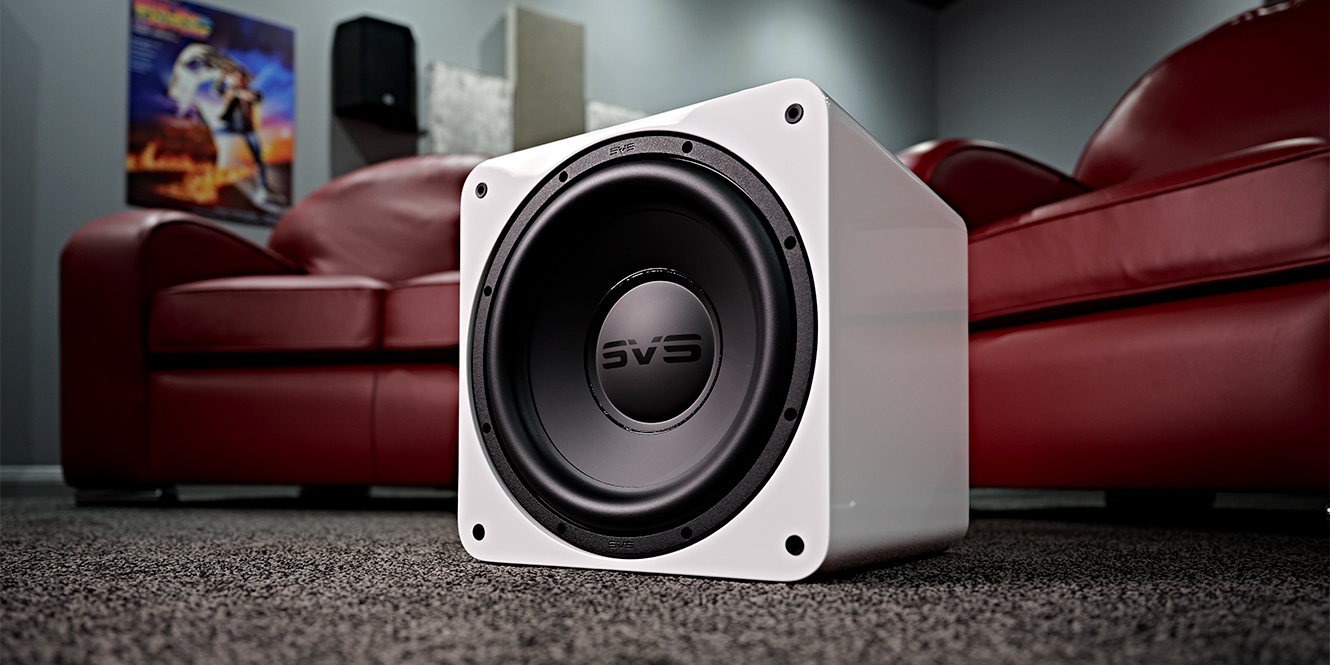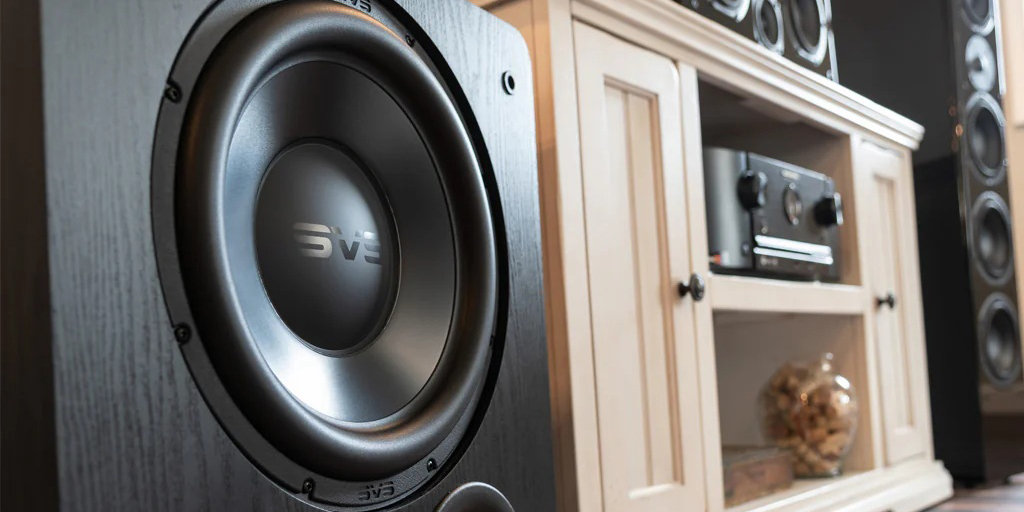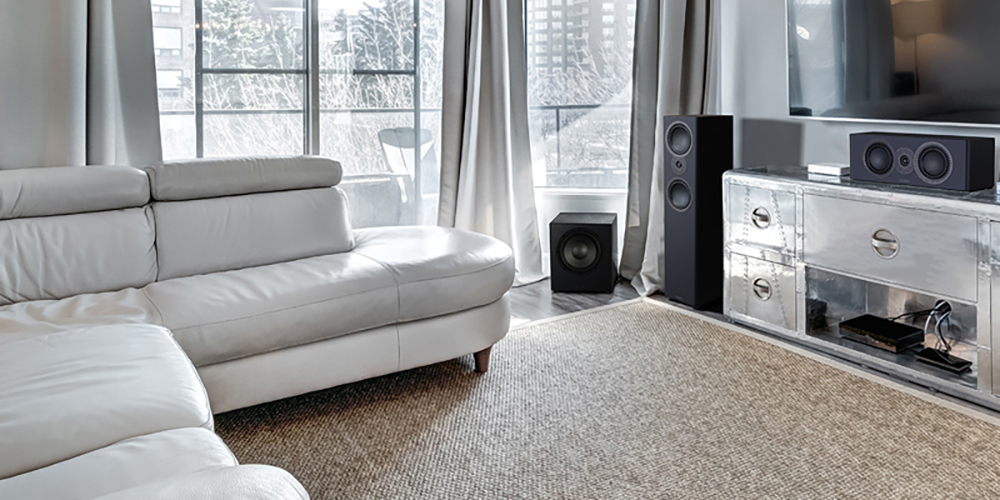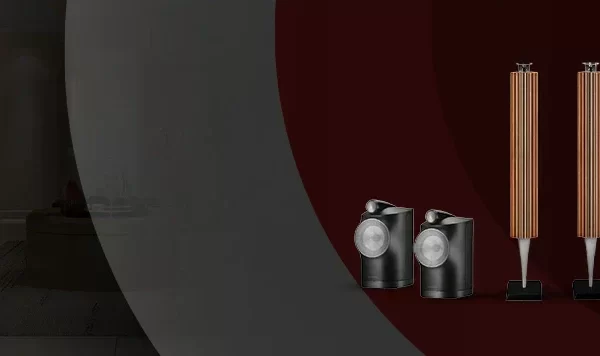
Guides, Guides, Home Cinema
If you’re setting up a home cinema and want to get the most out of your sound system, finding the right place for your subwoofer can make a big difference. The best subwoofer position creates a bass response that feels immersive and consistent, bringing that cinematic rumble into your living room without it becoming overwhelming or uneven.
For music lovers, this becomes even more important. In rooms where you’re not using automatic room correction, it’s worth paying attention to placement in order to deal with timing alignment and minimise problems like standing waves.
In this guide, we’ll take a closer look at how to position your subwoofer for the best possible performance.
In a hurry?
In short, here’s how to find the best subwoofer position:
- As bonkers as it sounds, try the “subwoofer crawl”. It’s one of the most effective ways to find the ideal spot relative to your main listening position.
- Avoid placing the subwoofer too close to a wall. If you run into issues with sound quality, try using the rule of thirds (explained below).
- Make sure you understand speaker alignment – this helps prevent phasing issues and timing delays.
Why is the subwoofer position important?
Subwoofers produce an omnidirectional sound, so it might seem like their placement isn’t all that important. However, unlike traditional passive speakers, subwoofers are specifically designed to handle low frequencies – powerful sound waves that you not only hear but also feel.
If, after installation, your subwoofer blends seamlessly into the sound, creating a full, rich audio experience that you only notice is missing when it’s turned off, then you’ve struck lucky. For most people, it takes a bit more effort to get it right.
Frequencies generated by a subwoofer can be anywhere between 240Hz and 20Hz; however, some subwoofers, like the SVS PB3000 subwoofer, go below that figure. At these ultra-low frequencies, the sound becomes something you feel, with waves powerful enough to move air around the room and even cause objects to rattle.
It’s important to position your subwoofer correctly to avoid any boominess that bounces around the room. In some cases, the effect can even be physically uncomfortable, causing a sensation that’s felt in the stomach. The right subwoofer placement will ensure your film is brought to life with rich, powerful bass that engulfs you in the action.

Where to position your subwoofer
Room considerations
Almost any home cinema or hi-fi setup can benefit from a well-placed subwoofer, but it’s important to analyse the room itself. The size, shape, and furnishings of a room can impact how a subwoofer (and any other speaker) performs.
Minimalist interiors with hard surfaces can lead to excessive sound reflections, while small, square or rectangular rooms often struggle with standing wave issues. Although some of these problems can be addressed through positioning and setup, not all can be fixed this way.
This is where room treatment and soft furnishings come in. By absorbing or diffusing problematic reflections, they help to reduce the negative effects of standing waves. Strategically placed panels and furnishings can make a noticeable difference, resulting in a more balanced and enjoyable listening experience.
The “subwoofer crawl”
If you’re new to home cinema or adding a subwoofer to a hi-fi setup, this next suggestion might sound a bit odd – but bear with us. The subwoofer crawl is one of the most effective ways to find the ideal placement in your room.
The idea behind the subwoofer crawl is to identify the spot in your room where bass response sounds best, because no two rooms behave the same acoustically.
Start by placing your subwoofer near your main listening position, ideally elevated to around ear level, and connect it to your AV receiver. Play an ultra-low frequency tone at an audible level.
Now, here’s the unusual part: crawl around the edges of the room at the same height as your subwoofer, listening carefully. The spot where the bass sounds the most balanced and powerful is where your subwoofer should go. It might sound a bit unconventional, but it really does work.
Avoid placing the subwoofer against a wall
There are two common approaches to subwoofer placement. The older method suggests placing the subwoofer in a corner to gain a 3dB power boost. While this can still work for some legacy setups, it’s more of a shortcut than a true solution, and it only takes you so far.
Modern active subwoofers are far more capable, offering consistent performance across a wider frequency range. However, placing one too close to a wall can lead to problems, such as triggering what’s known as the “rule of thirds” and causing issues with timing alignment – more on that below.
The rule of thirds
As mentioned earlier, boominess can be a real issue, and this is where the rule of thirds becomes particularly useful.
The problem arises when sound waves reflect off walls and interfere with themselves, creating an exaggerated bass response. The rule of thirds states that you should position the subwoofer roughly one-third of the way into the room from the wall. This can help smooth out the bass and reduce this boominess.
In more problematic rooms, you may need to move the subwoofer even further from the wall until the excessive resonance subsides.
Align your sub with the speakers
When using forward-firing subwoofers – where the bass driver faces towards the listener – it’s important to align them squarely with both the main and centre speakers.
Why does it matter? Because it helps achieve what’s known as “time alignment”. Without proper alignment, you may encounter issues like phase cancellation and timing mismatches.
While most AV receivers can apply digital corrections to address this, physically positioning the subwoofer accurately allows it to perform at its best without relying on digital compensation, which can sometimes affect the overall responsiveness of your system.
How a subwoofer works
Subwoofers typically feature larger bass drivers than those found in passive speakers, with 254mm (10 inches) being the standard size for a true subwoofer.
The primary role of a subwoofer is to produce large low-frequency pressure waves. Designs vary; some subwoofers are ported to enhance output, while others are sealed for a tighter, more controlled response.
In general, smaller bass drivers respond more quickly than larger ones but can’t reach the same low frequencies. To strike a balance, some subwoofers use dual drivers – often around 150mm each. This configuration provides a similar total surface area to a single larger driver, allowing them to perform at a similar level while being more responsive.

Why buy a subwoofer for your TV?
If you want to experience the ultra-low frequencies that a subwoofer can produce, it’s unlikely you’ll get anything close from a modern TV. Most TVs simply aren’t designed to handle those kinds of frequencies.
This comes down to design limitations. Ultra-thin TVs don’t have the physical space needed for a large bass driver or the powerful magnet required to control it. The engineering behind a subwoofer – driver size, magnet strength, and the air movement around the driver array – requires space that flat-panel TVs can’t provide.
In theory, you could build a thin subwoofer using line-array technology and extremely powerful (and expensive) magnets – but the cost would be so high that no TV manufacturer would consider it a viable option.
So why does it matter? Because bass is more than just sound – it’s something you feel. When watching a blockbuster film, that physical impact is part of the experience. Without a subwoofer, you’re only getting a fraction of what the sound mix was designed to deliver.
It’s not just about low-end rumble. A well-integrated subwoofer also enhances clarity across the entire frequency range.
FAQs
What’s the best position for a subwoofer?
There’s no single best subwoofer position – every room behaves differently, and even expert advice involves a bit of educated guesswork. That’s why we recommend trying the subwoofer crawl. It’s a practical and reliable method for identifying the ideal position in your specific space.
Is it better to have your subs facing in or out?
You should generally position the subwoofer’s driver facing into the room – unless the subwoofer has been specifically designed to operate differently. This ensures more effective bass distribution and interaction with the listening environment.
Why choose down-firing subwoofers?
Speakers that direct sound upwards or downwards tend to create a more even, 360-degree sound presence. In the case of down-firing subwoofers, this allows for greater placement flexibility, as the bass becomes less directional and more diffuse. As a result, they’re generally less detectable in the room compared to forward-firing models, making them a good option when space or layout is a concern.
Final thoughts
As you’ve probably gathered by now, there’s no single best subwoofer position that works for every room – only the right position for your room.






